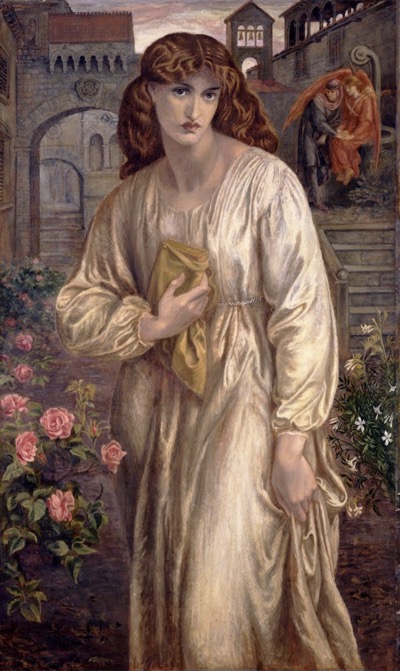The figure of Beatrice gleams from the canvas, and there is good reason for this. Rossetti, bent on capturing the reflection of light off the satiny fabric that she is wearing, included flecks of gold leaf in the paint. The model depicted is instantly recognisable as Jane Morris, the daughter of a groom and a domestic servant, who was plucked from poverty thanks to her beauty.
She modelled for Rossetti and his contemporaries, including William Morris, a fellow pre-Raphaelite, who married the youthful Jane. Treated to a private education after their engagement, Jane rapidly learned Italian and French, could play the piano with great proficiency and is believed to be the inspiration for Bernard Shaw's Pygmalion, which in turn inspired My Fair Lady. Rossetti's favoured model aside, his works are full of symbolism. Beatrice dominates the image, while the picture is balanced by the arch on the left and the small two figures on the right, formed into a circular shape that almost mimics the arch thanks to the wings of what seems to be an angel archer, all dressed in red.
This is the personified figure of Love, who is comforting Dante as they regard the beautiful figure of Beatrice. Of course, Beatrice is the whole reason that Dante has ended up in Hell: he hopes to find her. Beatrice is clearly the focal point of the painting, being so close to the foreground that little else can be seen around her. Her gown, as mentioned above, glows in the light, almost dazzling, while in the background flowers blossom. To the left, pink roses bloom, so heavy that they bend the stems on which they grow, while on the left small white daisies sparkle like muted stars.
Beatrice is facing forward, but does not boldly meet the viewer's eye. Instead she seems to be pensively lost in thought, perhaps musing on whatever words lie between the covers of the book she is holding protectively, wrapped, as it is, in a silk kerchief, or scarf. Rossetti's skill is especially noticeable in the small details, for which he was famed: the ripple of her hair, the leaves on the roses and the way her hand clutches the fabric of her gown. The Salutation of Beatrice was completed in oil paint, on canvas, in about 1880-1882, in Rossetti's last years of life.




